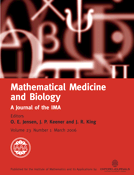-
Views
-
Cite
Cite
James P. Keener, Stochastic calcium oscillations, Mathematical Medicine and Biology: A Journal of the IMA, Volume 23, Issue 1, March 2006, Pages 1–25, https://doi.org/10.1093/imammb/dql002
Close - Share Icon Share
Abstract
While the oscillatory release of calcium from intracellular stores is comprised of fundamentally stochastic events, most models of calcium oscillations are deterministic. As a result, the transition to calcium oscillations as parameters, such as IP3 concentration, are changed is not described correctly. The fundamental difficulty is that whole-cell models of calcium dynamics are based on the assumptions that the calcium concentration is spatially homogeneous, and that there are a sufficiently large number of release sites per unit volume so that the law of large numbers is applicable. For situations where these underlying assumptions are not applicable, a new modelling approach is needed. In this paper, we present a model and its analysis of calcium dynamics that incorporates the fundamental stochasticity of release events. The model is based on the assumptions that release events are rapid, while reactivation is slow. The model presented here is comprised of two parts. In the first, a stochastic version of the fire-diffuse-fire model is studied in order to understand the spark-to-wave transition and the probability of sparks resulting in abortive waves versus whole-cell calcium release. In the second, this information about the spark-to-wave transition is incorporated into a stochastic model (a Chapman–Kolmogorov equation) that tracks the number of activated and inactivated calcium release sites as a function of time. By solving this model numerically, information about the timing of whole-cell calcium release is obtained. The results of this analysis show a transition to oscillations that agrees well with data and with Monte Carlo simulations.





